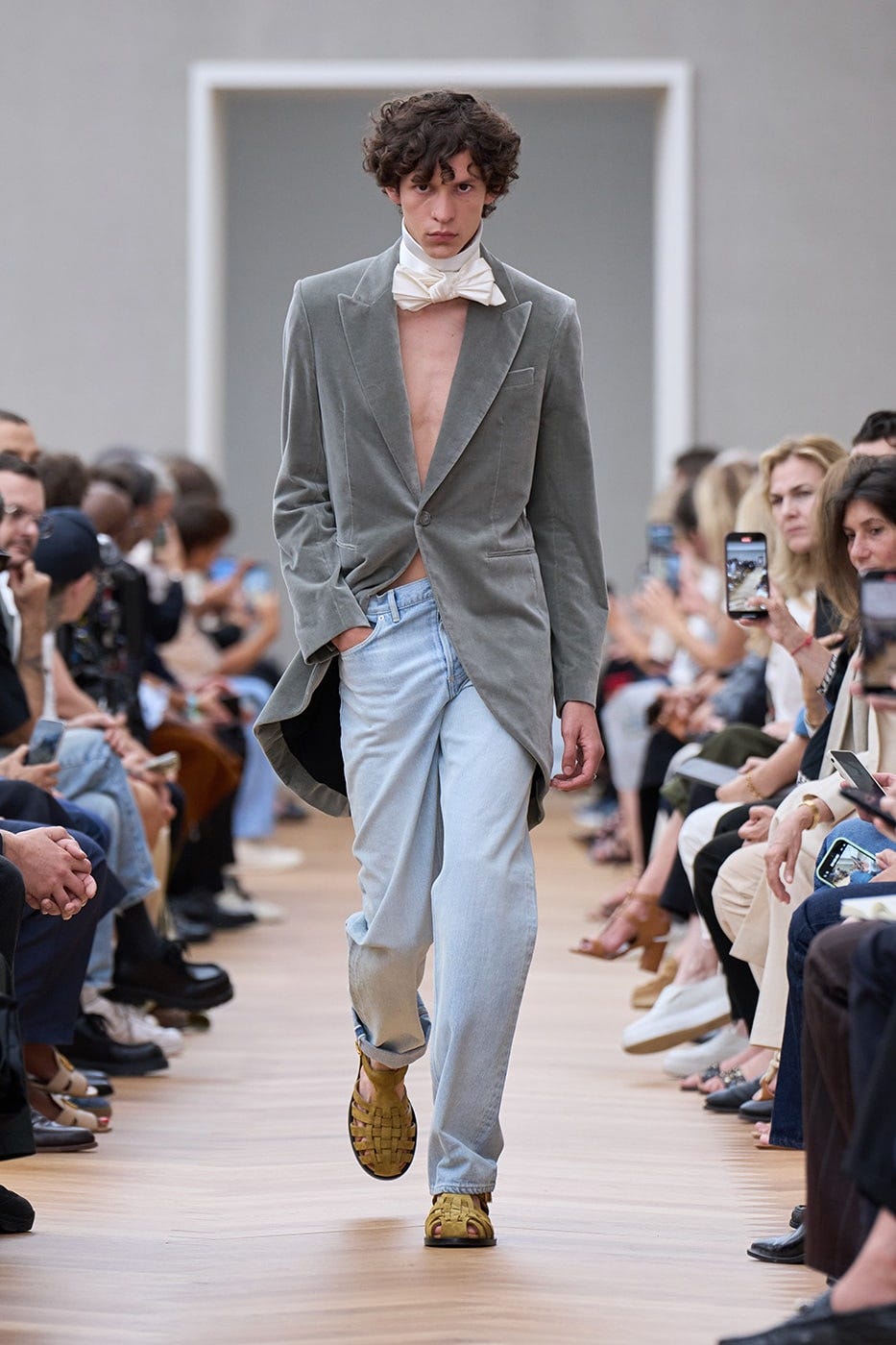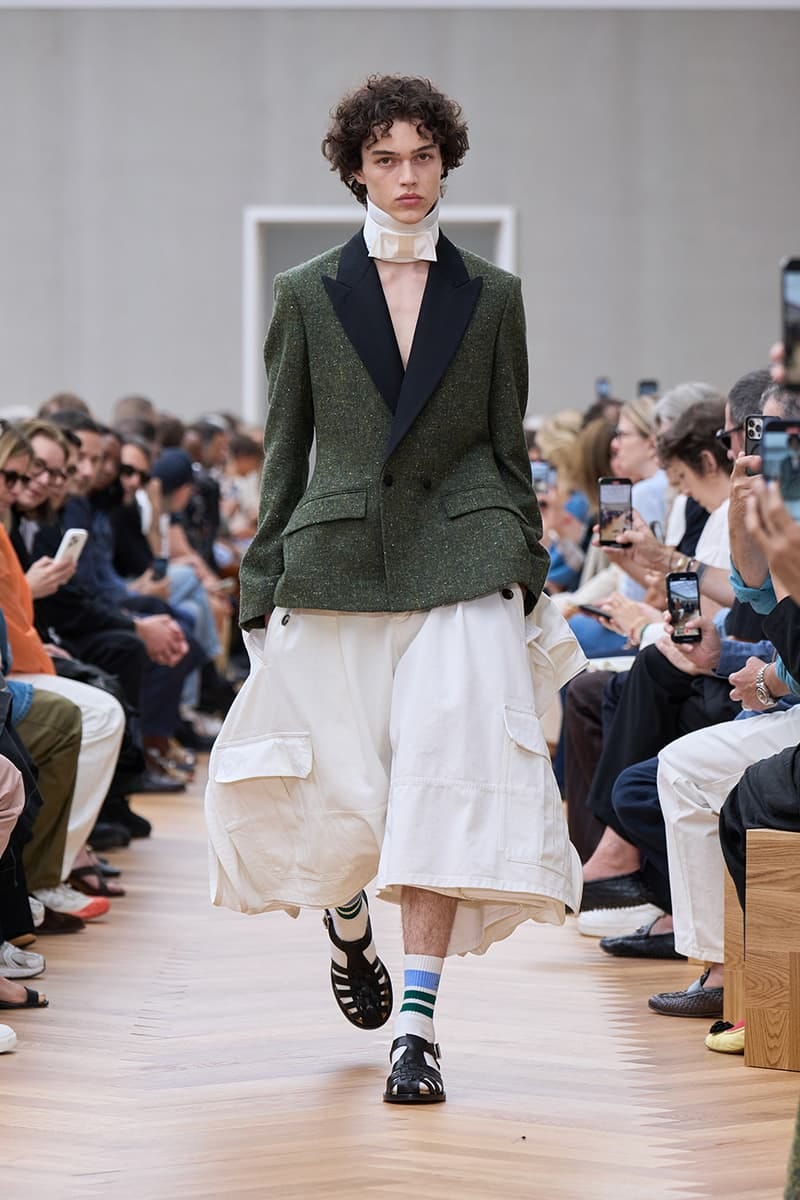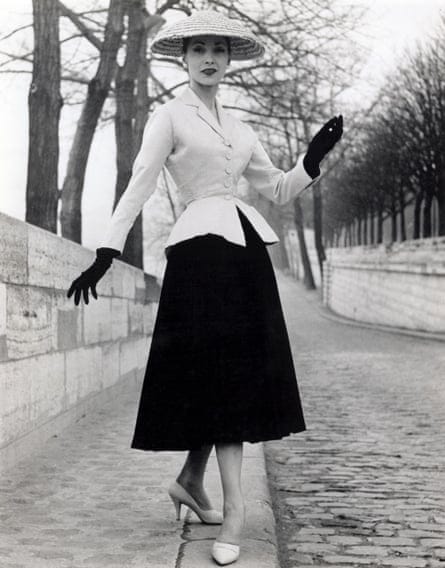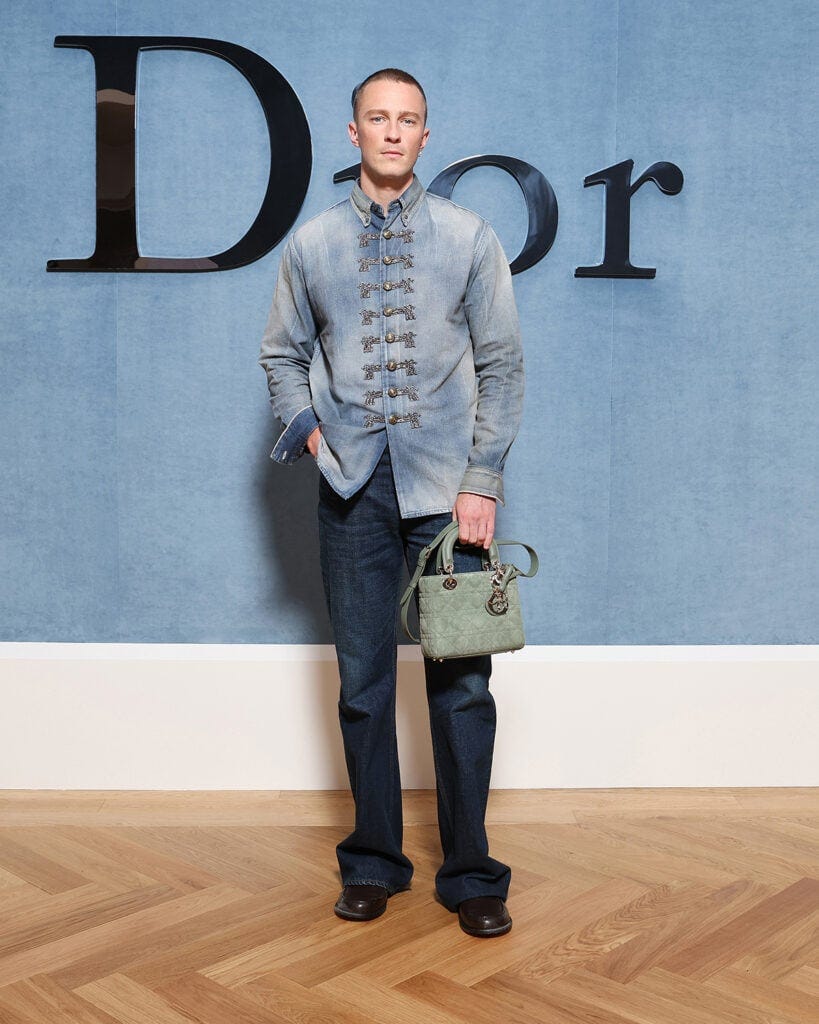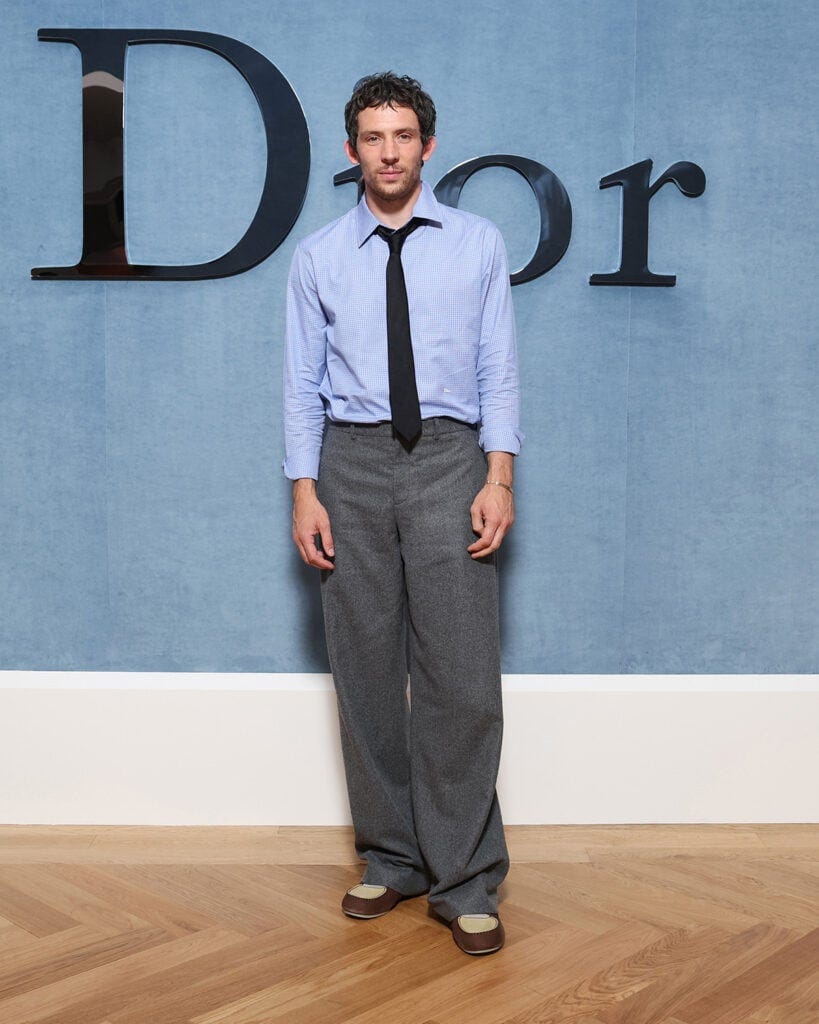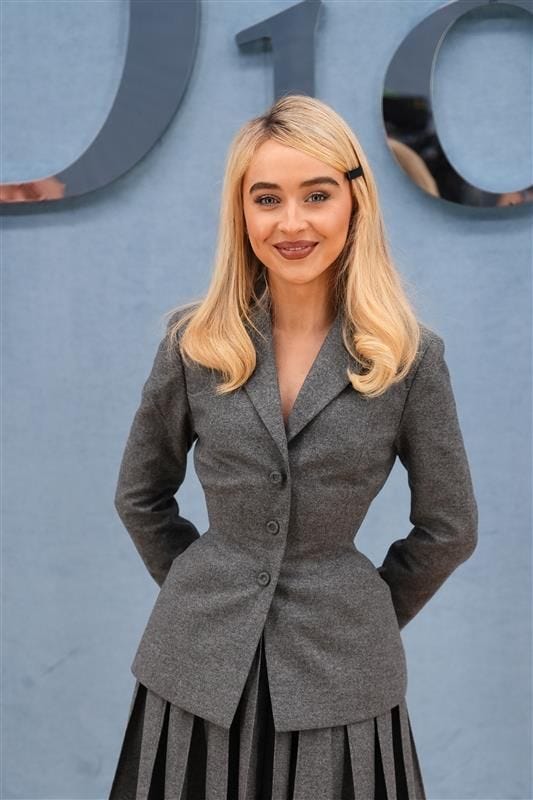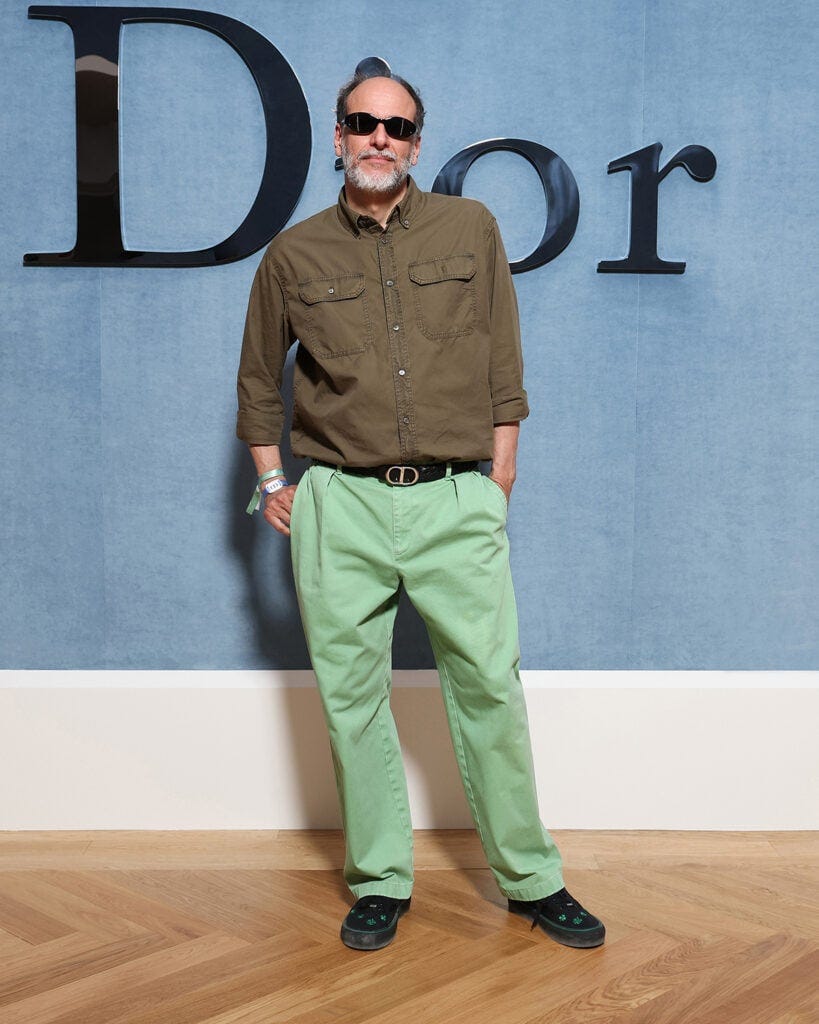Jonathan Anderson Raises the Curtain On His Dior
“It’s like the new type of 18th century ready-made.”
“Everything looks like you want to wear it.”
- Robert Pattinson after seeing Dior SS26
Jonathan Anderson’s appointment at Dior — a long time rumored, an even longer time coming — is unequivocally the biggest moment for the fashion house since Carrie Bradshaw slipped on a puddle of her own design and pratfell at the brand’s Avenue Montaigne boutique in 2004. It’s also a huge moment for fashion. For art. For business. For the zeitgeist. It’s not every day, probably not even every decade, that you get a changing of the guard at this level (I’m reminded of Tim Cook revealing the iPhone 4S in 2011, the first time he presented an iPhone to the public since taking over from Steve Jobs), one whose decisions won’t just impact a multi-billion dollar company, but also the way people dress and, more acutely, the way people think about the world — if we may be so grand.
It’s risky. It’s exciting. It’s something to yammer about on the subway and in Close Friends posts on IG. In short: It’s something I want to be talking about, thinking about, reading about, listening to other people talk about — all of the abouts.
I’m interested in the reviews, sure, but they mean little to me personally. I care most about the conversation the collection provokes and how it will shift both the brand and, as Anderson is wont to do, the industry at large. It’s why titans of the industry like Donatella Versace, Pierpaolo Piccioli, Glenn Martens, Chemena Kamali and Daniel Roseberry made sure they had calendar holds for the event of the season.
But this is bigger than just a fashion story. There’s simply no other news item at this level of attention that captures the intersection of art and commerce. Anderson’s debut on Friday via a men’s collection presented at Hôtel des Invalides in Paris felt like appointment viewing akin to Coco Gauff at the French Open or a new episode of The White Lotus.
Jonathan is very much for fashion-heads (sure and obviously) but what truly discerns him from so many of his peers is his ability to conjure intrigue from those who typically wouldn’t be tuning in — not because they don’t care, but perhaps because their attention was elsewhere or they simply didn’t know to look. His essence is a magnetizing force of attention that somehow communicates big ideas without dumbing them down or sanitizing them. “Do you think he’s exhausted?” a friend asked me as we made our way backstage after the show. “I don’t… I think he feeds off of this and it nourishes him.” Developing every single fabric from scratch? No problem!
But let’s take a step back and table set.
Why such a big deal? Dior sits within LVMH, a holding company and conglomerate that controls around 60 subsidiaries that manage 75 luxury brands. As of December 2023, Dior controlled around 42% of the shares and 57% of the voting rights of LVMH, making it a power player within a company that was the first ever in Europe to surpass a valuation of $500 billion just several years ago. They’re so massive, it’s hard to even wrap one's head around how wide they reach. There's wines and spirits, fashion and leather goods, perfumes and cosmetics, watches and jewelry, and then there's other facets of the business called selective retailing (examples: Sephora, Le Bon Marché) where the brand profits via a steep percentage of sales, and what's known as "other activities,” which includes, for instance, Royal Van Lent (a leading builder of high‑end yachts), and Cheval Blanc and Belmond, which operate a collection of high-end hotels. What about, say, a news publication? They own one of those too.
So Dior is big. Big big. But so is Anderson, who will become the first designer since Christian Dior himself to oversee all creative aspects of the Dior fashion house, which includes women's, men's and haute couture collections. He’s won awards — Designer of the Year at the Fashion Awards and International Designer of the Year at the CFDAs — sure, but he’s also, perhaps more impressively, made fashion seemingly less exclusive without altering the bottom line. He’s broadened the offering beyond the material items and crafted worlds that people want to immerse themselves in — people that don’t traditionally think about, let alone engage with, fashion. And speaking of that bottom line: At Loewe, a secondary LVMH house, he transformed sales from €230 million in 2014 to an estimated €1.5–2 billion in 2024 according to Morgan Stanley.
And what is a Creative Director actually? It can be easy to think of them as a designer. Because often they are. But that really ceases to capture the wholeness of what they do, especially for a brand of significant scale like Dior. “I just think it’s curating,” Anderson told me last year in an interview.
“Like, in your bedroom, ‘I want the lamp here, I want the wardrobe here.’ And then, six months later, you’re like, “I want the wardrobe here.’ You’re continually moving things around in a room. The brand is the house and then you are redecorating it every week. So for me it’s about trying to find curiosity within all of these things that work together in a room.”
I asked him if he found the job of being curious to be an easy one. Simply: “Yeah,” as though to say, “Obviously.”
He describes these curiosities as “new obsessions,” and they often lead to other new ones through the wormhole of obsession. It can be American painter Albert York; he’ll discover he was collected by Jackie Kennedy, which will lead him to Sotheby's to seek out the catalogue of Kennedy’s auction, which will then lead him to other new obsessions. But they’re not surface-level obsessions.
“Once I get into something, I have to know everything about it.”
This is when he deploys a research team to join him on the quest of obsession.
“It’s about the spontaneous acts of finding curiosity in the most banal thing.”
And thus, something as seemingly simple as a button can be (and was!) reimagined under his authority.
When appointing a Creative Director, there’s a lot at stake fiscally, as is the case with any changing of the guard within a successful business. But if a brand is willing to play the long game, even an initial dip in sales can prove a lucrative investment. Take Celine, for instance, which saw significant growth under Hedi Slimane’s steed from 2018 to 2024 after an initial decline in the wake of Phoebe Philo’s exit. This to say, this really is the opening act and less of a make-or-break moment for this new creative partnership. And that’s not even bringing into the conversation the reputational risk and press strategy around communicating new, big ideas within a house steeped in heritage. Take, for instance, the reimagining of the Bar jacket (the opening look of the collection), or “the New Look,” as it’s often called.
When Christian Dior debuted the New Look in 1947, he did so by taking inspiration from the pannier-supported skirts of the Baroque period, the low necklines and elevated bust of the Victorian era and the heavily corseted waists of the Edwardian years.
In other words, he drew on the past to inspire a new future. “I love this idea of collage on collage on collage,” Anderson told me last year.
“Then you do the show, and then the whole thing is another collage and then kids look at it online and they collage it again. It’s never-ending.”
So much of this collection drew on collaging silhouettes and references of the brand’s past (I particularly loved the Marc Bohan cloak cape homage).
As Vanessa Friedman noted in the New York Times:
“He was never going to toss everything out the window and start again. He couldn’t. Dior is a multibillion-dollar business, after all, and some of his predecessors (Raf Simons, Hedi Slimane, John Galliano) were his idols.”
You can read the reviews from the notables. Here’s a few bites if you’re interested.
Vanessa Friedman: “The result may not knock you sideways, but it’s likely to make you sit up and buy.”
Tim Blanks: “Colliding artistry with calculated artlessness, the designer's debut offered up a great appetizers for a more complex meal to come.”
Alexander Fury: “The mix of clothes, of references, of eras and approaches, was mind-boggling in its sophistication and complexity, in its deep grasp of Dior. It certainly wasn’t just about the clothes.”
Mimma Viglezio: “At first sight, when I watched it, quickly and superficially, it didn’t give me much. But then I thought someone as clever and as good a designer as Jonathan Anderson cannot leave me indifferent, especially for such an important debut. So I took time to go into the collections and tried to unpick the references and the more I looked at it, the more it ignited an excitement in me and the more I loved it.”
Or you can parse the VIPs (most of whom were wearing looks from the new collection as well as some sneak peaks of the womenswear debut):
Rihanna and A$AP Rocky.
Robert Pattinson and LaKeith Stanfield.
Drew Starkey.
Josh O’Connor.
Sabrina Carpenter.
Daniel Craig.
Mia Goth.
Luca Guadagnino.
Ethel Cain.
The list was expectedly endless, and no doubt will continue to grow even more come September. The sheer force of celebrity is another feather within Anderson’s cap. It’s not just gathering them all together in a room (a feat unto itself); it’s really their desire to be there — not out of obligation or to see and be seen, but really, mostly, the desire to witness history and to have a brief exchange with Anderson backstage.
And then you can parse social media, where there’s no shortage of opinions, breakdowns, reactions, reviews, monologues and commentaries on every aspect of the show, ranging from the informed to the imaginative, each effectively collaging the world Anderson has begun to create. A world brand new; a world I desperately hope — and am optimistic — can be better than this one.









